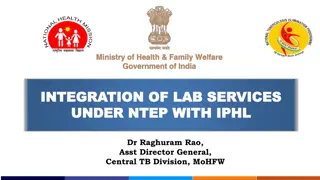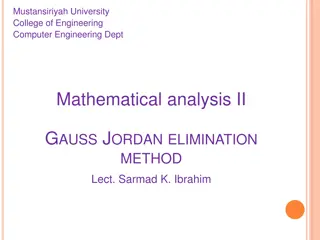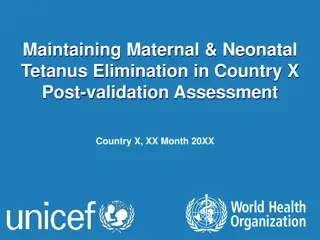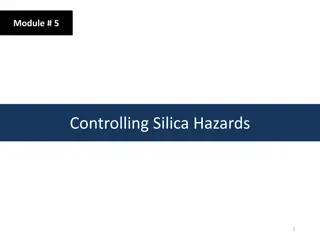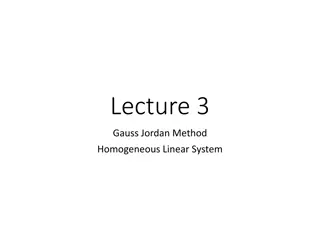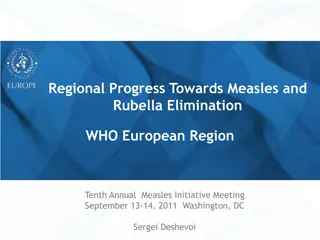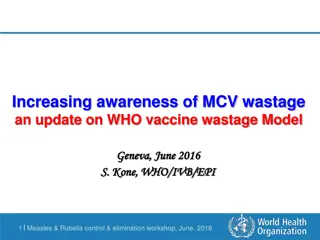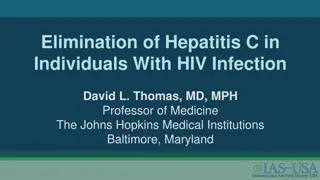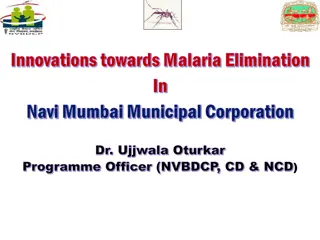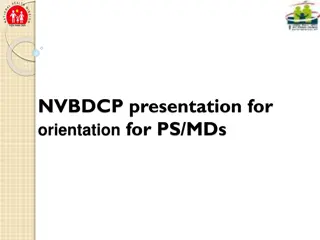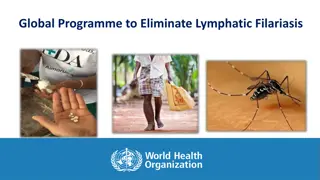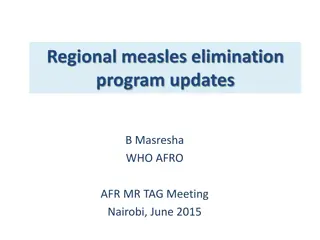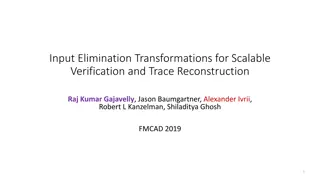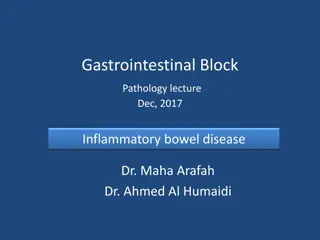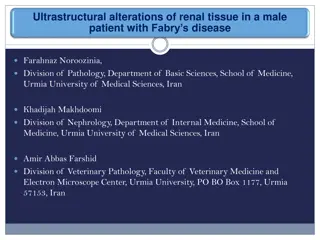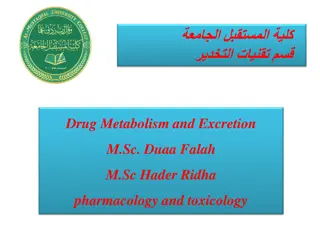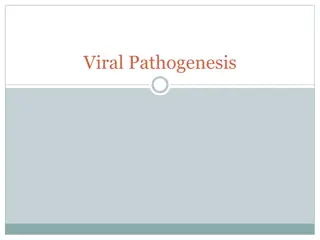Understanding the Natural History of Disease Development and Prevention
The natural history of disease development outlines the progression of a disease in an individual without intervention, from exposure to outcome. Learning objectives include defining prevention terms, understanding disease severity, prevention levels, and intervention measures. Studying disease prog
4 views • 16 slides
Understanding Urinary Elimination: Anatomy, Physiology, and Function of the Kidneys
The lecture covers the fundamentals of urinary elimination focusing on the kidneys' location, structure, function, and the role of nephrons. It discusses the transport of urine through the ureters to the bladder, highlighting the bladder's muscle layers and the urethra's role in expelling urine. Stu
3 views • 37 slides
Understanding Pharmacokinetics in Clinical Pharmacology
Pharmacokinetics, as explained in a lecture by Oula Mohammed Sami, M.B.Ch.B/MSc in clinical pharmacology, delves into how the body processes drugs, contrasting with pharmacodynamics which focuses on drug actions. Key topics covered include properties influencing treatment outcomes, the significance
6 views • 45 slides
Principles of Epidemiology: Understanding Disease Occurrence and Surveillance
Epidemiology is the study of disease patterns, factors influencing disease occurrence, and the core functions of surveillance, field investigation, and analytic studies. It involves understanding disease characteristics, natural history, and evaluating the effectiveness of activities to mitigate dis
1 views • 25 slides
Understanding Exponential Decay in Ibuprofen Dosage
Explore the concept of exponential decay using an example of ibuprofen dosage elimination from the bloodstream. Learn how to calculate the remaining dosage at different time intervals based on the decay rate. Discover the relation between the initial dosage, elimination rate, and time passed.
2 views • 22 slides
Insights into Tyzzer's Disease: An Overview of a Bacterial Infection in Laboratory Animals
Tyzzer's disease is an acute bacterial infection affecting rodents and rabbits, caused by Clostridium piliforme. Discovered in 1917 by Ernest Tyzzer, the disease is characterized by necrotic lesions in the caecal mucosa, liver, and heart. Initially known as Bacillus piliformis, it was later renamed
2 views • 21 slides
Integration of Lab Services and TB Elimination Mission 2025
This document discusses the integration of lab services under NTEP with IPHL, led by Dr. Raghuram Rao from the Central TB Division, MoHFW. It also outlines the National TB Elimination Mission 2025 goals, diagnostic algorithms, existing lab networks, facility levels, diagnostics expansion, and extern
0 views • 17 slides
Understanding Disease Control and Prevention in Epidemiology
This article discusses disease control processes in epidemiology, including reducing disease incidence, duration, and transmission. It covers public policy interventions, elimination, eradication, and extinction of infectious agents. It also highlights preventable causes of disease and different lev
2 views • 10 slides
Economic Perspectives on Malaria Control and Elimination
Analyzing malaria control and elimination from an economic standpoint is crucial for understanding the long-term health outcomes, cost savings, operational strategies, funding gaps, and wider economic consequences of the disease. By examining the correlation between malaria and poverty, exploring fu
4 views • 21 slides
Understanding Gaussian Elimination Method in Linear Algebra
Gaussian Elimination and Gauss-Jordan Elimination are methods used in linear algebra to transform matrices into reduced row echelon form. Wilhelm Jordan and Clasen independently described Gauss-Jordan elimination in 1887. The process involves converting equations into augmented matrices, performing
4 views • 14 slides
Solving Systems of Equations by Elimination
Learn how to solve systems of equations by elimination method through examples, warm-up exercises, steps for elimination, and practice problems. Master this technique to find the unique values that make the equations true. Get ready to enhance your algebra skills with step-by-step guidance and visua
0 views • 13 slides
Maintaining Maternal & Neonatal Tetanus Elimination: Post-validation Assessment in Country X
This post-validation assessment report delves into the efforts to maintain Maternal & Neonatal Tetanus Elimination in Country X. It includes findings from field assessments, recommendations for sustaining the elimination status, and the critical role of surveillance in addressing vulnerable populati
3 views • 19 slides
Controlling Silica Hazards: Effective Engineering Controls
Techniques for controlling silica hazards in the workplace include elimination, substitution, and engineering controls like ventilation, dust containment systems, wet methods, and housekeeping practices. Elimination involves removing silica exposure risks, while substitution replaces risky materials
1 views • 21 slides
Overview of Sparse Linear Solvers and Gaussian Elimination
Exploring Sparse Linear Solvers and Gaussian Elimination methods in solving systems of linear equations, emphasizing strategies, numerical stability considerations, and the unique approach of Sparse Gaussian Elimination. Topics include iterative and direct methods, factorization, matrix-vector multi
0 views • 35 slides
Understanding Gaussian Elimination and Homogeneous Linear Systems
Gaussian Elimination is a powerful method used to solve systems of linear equations. It involves transforming augmented matrices through row operations to simplify and find solutions. Homogeneous linear systems have consistent solutions, including the trivial solution. This method is essential in li
0 views • 16 slides
Developing GEAR Framework for NTD Elimination Progress Evaluation
Designing an evaluation framework for NTD elimination progress, the Global Elimination or Eradication Advancement Review (GEAR) aims to enhance efficiency and effectiveness. The project involves stakeholder engagement, pilot design, and tool refinement within a structured timeline for strategic impr
0 views • 12 slides
Screening for Peripheral Vascular Disease in Patients with Coronary Artery Disease
Patients with coronary artery disease should be screened for peripheral vascular disease as it is a frequent integrator of global cardiovascular risk. The association of atherosclerosis in various arterial diseases highlights the importance of identifying multisite artery disease. The prevalence and
0 views • 23 slides
Prison Rape Elimination Act (PREA) Volunteer Training Overview
The Prison Rape Elimination Act (PREA) Volunteer Training provides participants with essential knowledge on the Act's purpose, Agency's Zero Tolerance Policy, definitions related to sexual abuse and harassment, and procedures for preventing, detecting, and responding to sexual abuse in prison enviro
0 views • 73 slides
Human Disease Symptom Network: Understanding Disease Relationships Through Symptoms and Genes
The Human Disease Symptom Network (HSDN) is constructed using a large-scale medical bibliographic records database to form a network of human diseases based on symptom similarities. By integrating disease-gene associations and protein-protein interaction data, correlations between symptom similarity
0 views • 37 slides
Progress Towards Measles and Rubella Elimination in WHO European Region
The WHO European Region has been making significant progress towards eliminating measles and rubella, with 96% reduction in measles and 97% reduction in rubella from 1990 to 2011. Strategies include ensuring high vaccination coverage and conducting supplemental immunization activities in susceptible
0 views • 24 slides
Understanding the Impact of Vaccine Wastage on Measles Elimination Efforts
This presentation focuses on the significance of vaccine wastage in the context of measles elimination, emphasizing the factors influencing wastage, why it matters for achieving high vaccination coverage, and tools for estimating wastage. The content highlights the challenges posed by wastage on vac
0 views • 13 slides
Elimination of Hepatitis C in Individuals With HIV Infection
Discussing the goals, treatment options, and global impact of Hepatitis C in individuals with HIV infection, this presentation by Dr. David L. Thomas from Johns Hopkins Medical Institutions sheds light on important aspects such as mortality projections, WHO elimination goals, and targets for hepatit
0 views • 40 slides
Innovative Approaches for Malaria Elimination in Navi Mumbai Municipal Corporation
Navi Mumbai Municipal Corporation, under the leadership of Dr. Ujjwala Oturkar, Programme Officer, is implementing various innovative strategies towards malaria elimination. With a total population of over 1.5 million, the corporation has established specialized hospitals, urban health posts, and co
0 views • 21 slides
Understanding Bacterial Diseases of Fish: Columnaris Disease Overview
Columnaris disease, also known as Saddleback disease, is a common bacterial infection in fish that is often brought about by poor handling and high stress levels. This disease manifests as tail and fin rot, leading to rapid fish mortality. The causative organism, Cytophaga (formerly Flexibacter), is
0 views • 21 slides
Accelerating Progress Against NTD Elimination: GEAR Evaluation Tool Discussion
Discussion draft for the Global Elimination or Eradication Acceleration Review (GEAR) focusing on evaluating progress against NTD elimination goals, specifically oncho outcomes. The draft covers findings, expert meeting goals, GEAR process overview, and strategic lessons for effectively presenting r
0 views • 13 slides
Understanding Elemental Diet in Pediatric Nutrition for EoE Treatment
Eosinophilic esophagitis (EoE) is a condition where certain foods trigger an inflammatory response. Elimination diets like the elemental diet, which involves amino acid-based formulations, have shown positive results in treating EoE in children. Implementing specific exclusion diets and milk elimina
0 views • 12 slides
National Vector Borne Disease Control Program Overview
The National Vector Borne Disease Control Program (NVBDCP) focuses on preventing and controlling diseases such as Malaria, Dengue, Chikungunya, Filariasis, Japanese Encephalitis, and Kala-azar. Implemented at state level, NVBDCP aims to eliminate these diseases through strategic planning, policy mak
0 views • 9 slides
Achievements and Progress of the Global Programme to Eliminate Lymphatic Filariasis
The Global Programme to Eliminate Lymphatic Filariasis (GPELF) aims to eradicate LF as a public health problem through mass drug administration and morbidity management. Significant achievements include treating billions of individuals, reducing infection rates in many countries, and validating LF e
0 views • 13 slides
Probabilistic Graphical Models Part 2: Inference and Learning
This segment delves into various types of inferences in probabilistic graphical models, including marginal inference, posterior inference, and maximum a posteriori inference. It also covers methods like variable elimination, belief propagation, and junction tree for exact inference, along with appro
0 views • 33 slides
Decoding Genetics: Insights from Alzheimer's Disease Symposium to Type 2 Diabetes Study
Explore the latest findings from the Alzheimer's Disease Genetics Symposium 2019 on disease mechanisms, drug targets, and genetic pathways. Dive into the progress made by the Alzheimer's Disease Genetics Consortium over the past decade. Transition to a Genome-Wide Association Study uncovering suscep
0 views • 42 slides
Progress Towards Measles Elimination in the African Region
The data presented showcases the progress and goals of measles elimination efforts in the African Region, focusing on targets for routine immunization coverage, introduction of MCV1 and MCV2 vaccines, supplementary immunization activities (SIAs), surveillance performance, and overall advancements to
0 views • 26 slides
Liver Disease Burden in Tower Hamlets
Dr. Somen Banerjee, Director of Public Health in London Borough Tower Hamlets, highlights the concerning liver disease mortality rates in the area, with high incidence of cirrhosis, cancer, and hepatitis B and C. The data reveals a significant burden of liver diseases such as Non-Alcoholic Fatty Liv
0 views • 18 slides
Input Elimination Transformations for Scalable Verification and Trace Reconstruction
This work introduces new input elimination techniques for scalable model checking in industrial applications, focusing on trace reconstruction. The transformations aim to make the netlist more tractable for solving, involving various algorithms such as retiming, phase abstraction, and bitwidth reduc
0 views • 27 slides
Understanding Inflammatory Bowel Disease: Crohn's Disease and Ulcerative Colitis
Inflammatory Bowel Disease (IBD) encompasses Crohn's disease (CD) and ulcerative colitis (UC), chronic conditions with immunologic basis. This article delves into the epidemiology, pathophysiology, and differences between CD and UC, highlighting clinical features, pathology, and complications like a
0 views • 42 slides
Understanding the Prison Rape Elimination Act (PREA) and Victim Advocacy
The Prison Rape Elimination Act (PREA) is the first federal law addressing sexual violence in detention facilities, setting standards for prevention and response. It requires compliance from various facilities and emphasizes access to victim advocacy services, outlining the roles and boundaries of a
0 views • 11 slides
Starting a Hepatitis C Elimination Program at Lummi
Learn about the Hepatitis C elimination program at Lummi Tribal Health Center, focusing on defining elimination, required interventions for HCV elimination, and the Lummi program's description. The activity offers 7 contact hours upon completion. No conflicts of interest are present, and the event i
0 views • 24 slides
Lazy Code Motion and Partial Redundancy Elimination in Optimizing Compiler
Lazy code motion, partial redundancy elimination, common subexpression elimination, and loop invariant code motion are optimization techniques used in compilers to improve code efficiency by eliminating redundant computations and moving code blocks to optimize performance. These techniques aim to de
0 views • 35 slides
Ultrastructural Alterations of Renal Tissue in a Male Patient with Fabry's Disease
Fabry's disease is a rare X-linked lipid storage disorder characterized by deficient lysosomal alpha-galactosidase A activity. This condition primarily affects males, leading to chronic kidney disease and progression to end-stage renal disease. Kidney involvement is a critical aspect, and high doses
0 views • 24 slides
Understanding Drug Metabolism and Excretion in Pharmacology
Drug metabolism involves the biotransformation of pharmaceutical substances in the body, primarily in the liver, to facilitate their elimination. This process helps convert drugs into less active forms for enhanced elimination through various reactions in Phase I and Phase II metabolism. Factors suc
0 views • 20 slides
Understanding Viral Pathogenesis: Causes and Consequences
Viral pathogenesis involves the process by which a virus leads to disease, exploring the interplay between viral and host factors. It encompasses the concepts of virulence, viral disease, and the effects on infected cells and the host's immune response. Changes within infected cells, including cell
0 views • 26 slides






